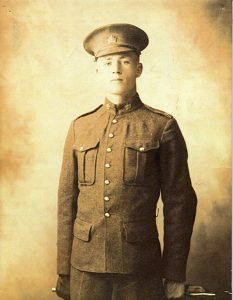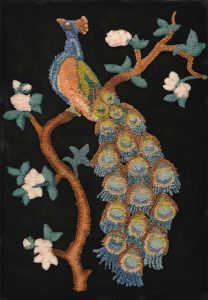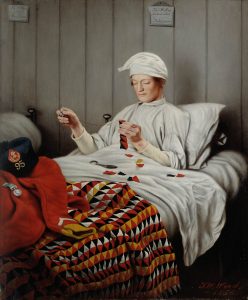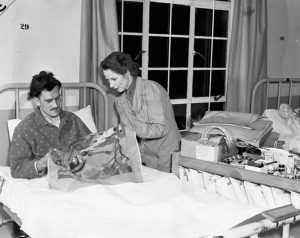The Healing Peacock and Greater Needs: Convalescence and Wounded Soldiers
The Example of Frank Neville Read’s Injuries and Recovery
Frank Neville Read was a farmer from Fort Qu’Appelle, Saskatchewan when he enlisted in 1915. By 1916, Read had suffered from shell shock. The following year, he suffered a gunshot wound in his arm. Then, while in England, he injured his hand in a train accident. As a result of his unfortunate experiences in 1916 and 1917, he ended up in a hospital in Bramshott, England.
While recovering from surgery on his hand in the hospital, he came under to care of a nurse. She found inventive ways to aid his recovery. She had him do embroidery to assist with the recovery of the motor skills in his wounded arm. She drew a peacock on a canvas and had Sergeant Read embroider it with wool.
The fine motor skills needed to stitch with wool and the constant use of a pair of clippers built up his muscles . Over time, he regained the use of both his arm and hand through the process of executing this embroidery.
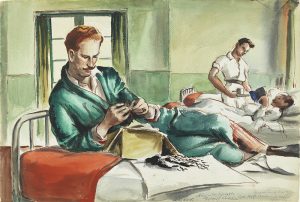
George Campbell Tinning painting, “R.C.A. Officer doing Handicraft Therapy, No. 1 Canadian General Hospital, Taplow, England, 1945.”
The use of embroidery as a form of recovery was practiced throughout the recovery of soldiers in many wars.
The More Profound Example of John Elwood’s Injuries and Needs
Many soldiers experienced injury even more profound than that experienced by Frank Read. John Elwood, for example, was a 35-year-old logger when he joined the service on November 7, 1914. When shot in the head during a battle on June 6, 1916, he suffered from several physical impairments.
As a result of his injury, he suffered dizziness, seizures and headaches. He lost the power of one arm and could not lift it or feel it at all. He had complete loss of sensation over the side of his neck and the right side of his chest. He also experienced impaired sensation in his right leg. He could walk but not run. Medical professionals assessed him as having 40% disability. It would be difficult, if not impossible, for him to find employment upon his return to Canada.
The Need for Institutional Care and Recovery
Situations like that of John Elwood necessitated something more than immediate short-term care. They also required something more than therapeutic art making. They demanded a more dynamic, collective and systematic approach to soldier recovery. This need resulted in The Department of Soldiers’ Civil Re-establishment .
If you would like to see more trench art and other Canadian war-related craft, click here.


